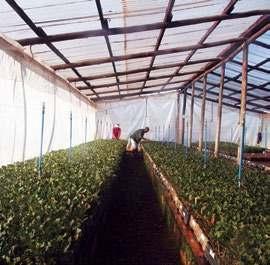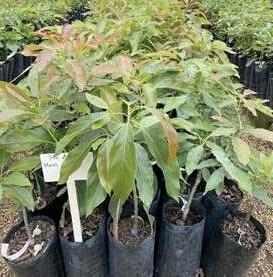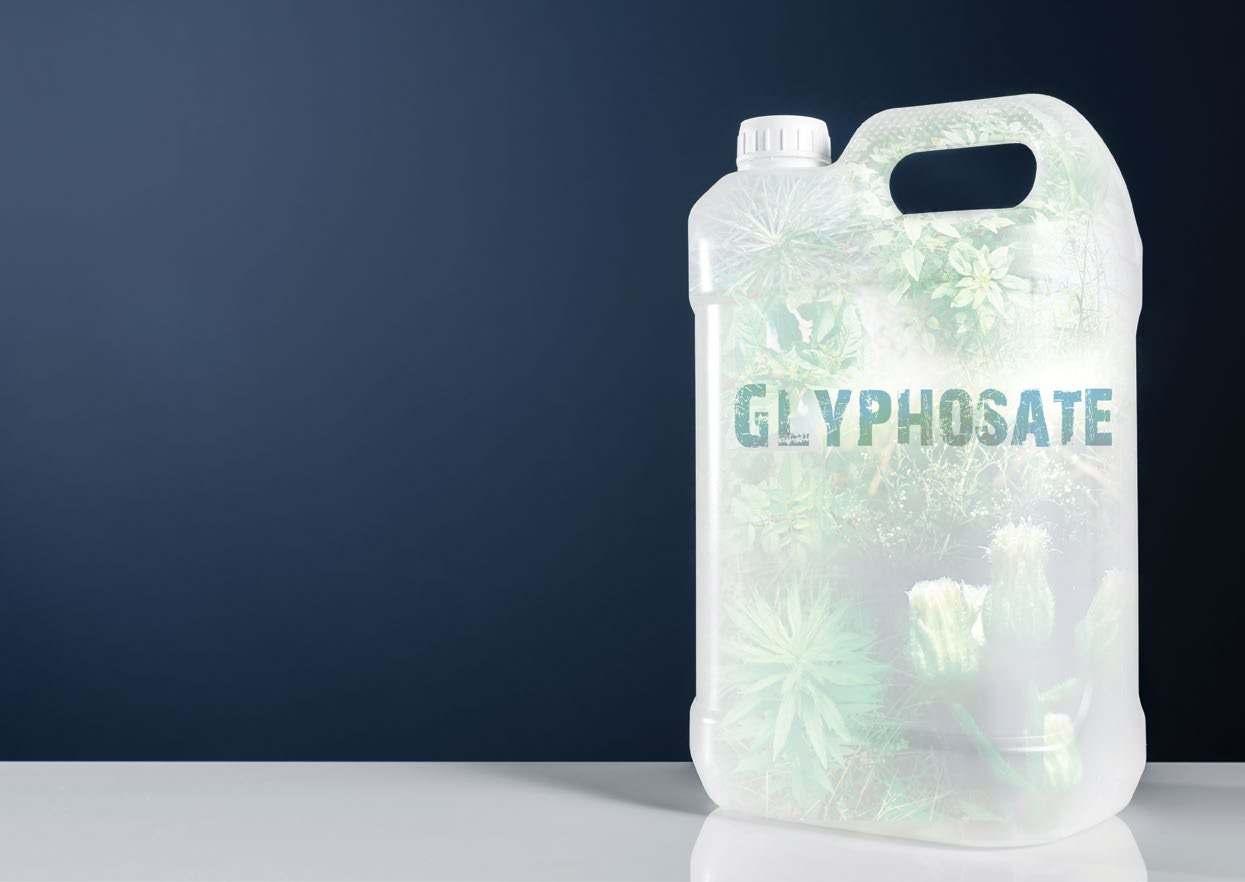
10 minute read
A spent wonder herbicide?
The future prospec ts of glyphosate herbicide for the management of weeds in subtropic al fruit orchards
While crop production is beset with several daunting challenges, herbicides have made significant contributions to sustainable food production. Chemical selection pressure made it inevitable that herbicidal efficacy eventually resulted in weed resistance. Herbicide options in the three subtropical crops are relatively limited, therefore non-chemical weed control practices ought to be given high priority.
Charlie Reinhardt
PROFESSOR IN AGRONOMY, NORTH-WEST UNIVERSITY SUBTROP JOURNAL
There can be no disputing the fact that herbicides have made significant contributions to sustainable food production since the 1940s with the introduction of the first selective herbicides (2,4-D and MCPA) i.e. synthetic organic chemical compounds with the ability to kill unwanted plants (weeds) without the crop being harmed.
Modern crop production is beset with several daunting challenges, of which the most important are: burgeoning human populations, shrinking of arable land, climate change, genetic limitations of crop yield, scarce water resources, adverse environmental impacts associated with agricultural practices, and herbicide-resistant weeds. Given increased public pressure for absolutely safe agrochemicals, which implies zero risks for human health and the environment, even herbicides, which generally target life processes unique to plants, have come under intense scrutiny.
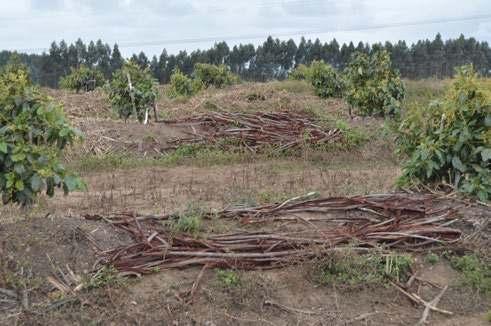
Organic mulch with wattle bark can also be effective, but then it would need to be better applied than in this picture. Wattle has allelopathic potential.
Weeds and weed control into the future Humanity’s increased future food needs impose the adoption of intensifed agriculture that is sustainable, not only in the sense of meeting future food demands, but also by ensuring that less land gets converted from natural areas for agricultural purposes. It is generally accepted that sustainable, intensified crop production will long into the future rely on synthetic chemicals for sustaining both high quality produce and high yields (Balmford et al., 2018; Duke et al., 2019).
The global agrochemical industry’s quest for novel chemistry to deal with the challenges of public pressure for safer products and environmental safety, is mired in high research and development costs and a ceiling in chemistry innovation (Dayan, 2019). According to Umetsu and Shirai (2020), no herbicides with a novel mode of action have reached the market in 30 years, and only one (cyclopyrimorate) was recently released and another is being developed.
Relatively new weed control technologies, such as sensordirected spraying and drone-operated sprayers, could contrib-
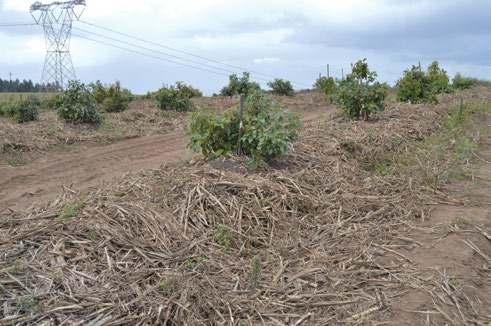
Organic mulch with sugarcane trash can be effective for suppressing weeds in young orchards which are prone to herbicide injury. Sugarcane has allelopathic potential.
TO PAGE 16
in die kol teen swartvlek

Geformuleer as ’n suspensie konsentraat met ’n waterbasis wat gewasveilig is en nie brandskade op vrugte veroorsaak nie Geregistreer saam met koper as

alternatief tot mankoseb Beskerm nuwe groei
ORTIVA® word sistemies in die xileem vervoer. Met kontakmiddels is daar ’n risiko dat infeksie op die onbeskermde dele van vrugte kan voorkom omdat hul oppervlak so vinnig vergroot. Kort onthoudingsperiode
op suurlemoene om te kompenseer vir onegalige blom
A spent wonder herbicide?
FROM PAGE 15
ute to a reduction in herbicide use, as could biological weed control through the use of cover crops and organic mulches. The extent to which such technologies and practices will be able to keep weeds in check will be sorely tested by the ability of weeds, relative to that of crops, to cope with climate change.
In general, in terms of plant growth and productivity, weeds are likely to repond more positively than crops can to increased CO2 levels and temperatures, making weeds even more competitive to crops than they currently are.
It is not far-fetched that the natural ability of crop species to produce and release phytotoxic (allelopathic) compounds into the environment can be genetically enhanced for exploitation as bio-herbicides. As early as the 1990s, the International Rice Research Institute embarked on the identification and breeding of rice cultivars with the ability to suppress weeds through the release of allelochemicals into the environment (Olofsdotter et al., 1997; 1998; 2001).
The release of plant-produced biochemical compounds that are phytotoxic i.e. allelochemicals, from living plants and plant litter, specifically their utility for weed control, is seldom given due credit for weed control achieved by cover crops and organic mulches. The latter practices’ role in weed control is often attributed solely to the physical suppression of weed growth and to preventing light from reaching covered weeds and the soil surface. In reality, both biochemical (allelochemical) and physical phenomena explain the weed suppressing roles of cover crops and organic mulches.
Glyphosate – the “once-in-a-century” herbicide Glyphosate first came onto the world market in 1974/75, also in South Africa, and has since become the mainstay herbicide for use in important annual and perennial cropping systems globally. Duke and Powles (2008) extolled the virtues of glyphosate and coined the phrase “a once-in-a-century herbicide” for it.
A particularly mutually beneficial association has been glyphosate use in zero-tillage systems devoted to glyphosatetolerant (Roundup ReadyTM) crops such as maize, soy and cotton. Glyphosate is also an important tool for weed management in perennial crop systems such as orchards and vineyards, as well as in forestry.
The phenomenal popularity of glyphosate has turned it into the world’s best-seller herbicide, which also means it was used in high volumes and high frequency in various crop systems, thus exposing many weed species to it. High use levels, coupled with high chemical selection pressure due to its phenomenal herbicidal efficacy, made it inevitable that glyphosate eventually ran into the difficult problem of weed resistance.
Being implicated in weed resistance is not unique to glyphosate; currently, 512 cases of herbicide-resistant weeds have been reported globally, and 266 weed species have evolved resistance to 21 of 31 known herbicide sites of action involving 165 different herbicides (The International Herbicide-resistant Weed Database, www.weedscience.org accessed 7 April 2022).
Worrying to those who depend on glyphosate are the threats to its continued use because of the unabated controversy raging over its safety for humans (Beckie et al., 2020). This situation is worsened by recent substantial price increases due to shortage of product in the market. This begs the question posed by Beckie et al. (2020): is farming without glyphosate possible?
We are already seeing restrictions being placed on the use of glyphosate, and its registration is even revoked in certain countries. As Beckie et al. (2020) so eloquently puts it: “In developed countries most voters live in urban centres; politicians naturally cater to eligible voters of whom farmers are becoming a smaller and smaller percentage over time (usually <5% nationally)”. Globally, the agri-food research and development sector is taking stock of such developments and contingency plans are being made.

Alternatives to glyphosate It is difficult to contemplate a world without glyphosate. It has many virtues, and from a weed management pespective, even weed resistance can be countered by measures such as supporting glyphosate with additional and different herbicide modes of action in a particular programme.
Furthermore, alternative non-chemical weed control methods such as mechanical, biological (cover crops and organic mulches) and cultural (cropping practices) should always be considered for augmenting chemical control. One thing is certain – increased costs for weed control are inevitable if herbicide resistance is to be dealt with successfully.
In subtropical fruit crops the weeds to look out for with regard to their ability to evolve resistance to glyphosate, include: Conyza spp. (tall fleabane; hairy fleabane; horseweed), Bidens pilosa (common blackjack); Parthenium hysterophorus (parthenium; famine weed), Amaranthus hybridus (pigweed); Sorghum halepense (Johnsongrass) and Eleusine indica (goosegrass). Close scrutiny of orchards for the presence of South Africa’s latest crop-debilitating, glyphosate-resistant alien invasive species, Amaranthus palmeri (Palmer amaranth), is strongly advised (Reinhardt et al., 2022).
Herbicides registered for use in mango, avocado and litchi orchards, based on Subtrop/SALGA January 2022 information, show that litchi production is in the most precarious situation with regard to diversity (lack thereof) in herbicide mode of action, given that only five herbicide types are registered,
including glyphosate and paraquat. If the latter two herbicides should fall away, it would create a crisis situation for litchi production as far as sustainability of effective weed management is concerned.
Although avocado and mango production are better off in terms of diversity in herbicide mode of action, the only herbicides registered for broad-spectrum control of sedges, broadleaf and grass weed species are glyphosate, paraquat and glufosinate-ammonium. Again, in the event of glyphosate and paraquat exiting the scene, over-reliance on glufosinate-ammonium will, sooner rather than later, promote the evolution of weeds that are resistant to it.
In general, herbicide options in the three subtropical crops are relatively limited compared to the situation in many annual crops. Therefore, non-chemical weed control practices ought to be given high priority, and weed management strategies should integrate chemical (herbicide) control with as many other methods as possible.
The subtropical fruit industry is advised to do all in its power to retain glyphosate; fundamental to such an effort is responsible use that calls for strict adherence to registered dosages and use frequencies, as well as combining different herbicide modes of action in a particular herbicide programme.
REFERENCES
BALMFORD, A., AMANO, T., BARTLETT, H., CHADWICK, D., COLLINS, A., EDWARDS, D., FIELD, R., GARNSWORTHY, P., GREEN, R., SMITH, P. & WATERS, H. 2018. The environmental costs and ben-
efits of high-yield farming. Nat. Sust. 1: 477-485. BECKIE, H.J., FLOWER, K.C. & ASHWORTH, M.B. 2020. Farming without glyphosate? Plants 9: 96. DAYAN, F.E. 2019. Current status and future prospects in herbicide discovery. Plants 8: 341. DUKE, S.O. & POWLES, S.B. 2008. Glyphosate: a once-in-a-century herbicide. Pest Man. Sci. 64: 319-325. DUKE, S.O., POWLES, S.B. & SAMMONS, R.D. 2018. Glyphosate –
How it became a once in a hundred year herbicide and its future.
Outl. Pest Man. 29: 247-251. OLOFFSDOTTER, M., NAVAREZ, D. & REBULANAN, M. 1997. Rice allelopathy – where are we and how far can we get? Brighton Crop
Prot. Conf. – Weeds. Proc. Int. Conf., Brighton, UK. 1997, 3A-3, pp 99-104. OLOFFSDOTTER, M. 1998. Allelopathy in rice. In: Oloffsdotter M (ed):
Allelopathy in rice, International Rice Research Institute, Manila,
Philippines, pp 1-5. OLOFFSDOTTER, M. 2001. Getting closer to breeding for competitive ability and the role of allelopathy – an example from rice (Oryza sativa). Weed Tech. 15: 798-806. REINHARDT, C., VORSTER, J., KÜPPER, A., FALCO, P., SIMELANE, A.,
FRIIS, S, MAGSON, J. & ARADHYA, C. 2022. A non-native Palmer amaranth (Amaranthus palmeri) population in the Republic of
South Africa is resistant to herbicides with different sites of action.
Weed Sci. 70: 183-197. UMETSU, N. & SHIRAI, Y. 2020. Development of novel pesticides in the 21st century. J. Pest. Sci. 45: 54-74.
Charlie Reinhardt is professor in agronomy at North-West University, and project lead in the South African Herbicide Resistance Initiative (SAHRI) at the University of Pretoria. He can be reached at 083 442 3427 or dr.charlie.reinhardt@gmail.com




We are entering our 50th year of commercial Macadamia tree propagati on. We are highly experienced, using Mother-Material from our own commercial blocks, which form one of the oldest Plant-Improvement schemes in South Africa. We off er our Growers high-yield potenti al from the start.
We off er West Indian / Guatemalan Avocado rootstocks graft ed to your culti var of choice. Data from source b.i. Agriculture Data Analyti cs shows the role of rootstocks in the yield and quality of Avocado producti on. Over a 7-year period, seedling rootstocks yielded the same average tonnage per hectare as clonal rootstocks.
An exciti ng additi on to your Subtropical agricultural development. SWEET-tasti ng Dragon Fruit selecti ons for local and export markets. Excellent returns per hectare. Opti onal: Join the Marketi ng Company and be part of the Amorenti a Sweet Dragon Fruit Brand!


